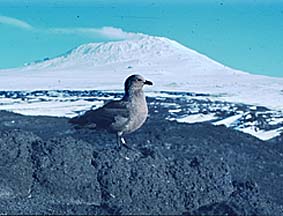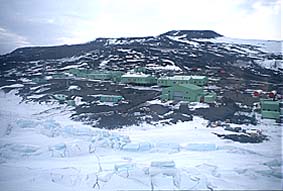Human
Involvement and Impact
Tourism
The first tourists visited Antarctica in 1958. Around 10,000
tourists now visit the continent each Austral summer
(December-February), most by ship. At issue is how to protect the
Antarctic landscape and its biota while allowing the tourists to
visit and experience Antarctica for themselves. Strict visitor
guidelines are in place to minimise potential damage, but there still
remains a real threat of a significant environmental disaster perhaps
resulting from a cruise vessel going aground.
- The Erebus tragedy
The first tourist flight to Antarctica was from Chile
in 1956. Overflights were introduced by Qantas and Air New Zealand in 1977
but were suspended after the Erebus tragedy. They have since been re-established
by Qantas and are still popular (3,146 passengers in 1997-8). The Erebus tragedy
involved an Air New Zealand DC-10 on a sight-seeing flight over the Ross Sea
region which crashed into the slopes of Mt. Erebus on 28 November 1979. All
237 passengers and 20 crew were killed in New Zealand’s greatest air disaster.
 |
Mount Erebus with a
south polar skua in the foreground |
Political
Despite the fact that seven countries have staked territorial
claims, no national government has internationally-recognised
jurisdiction over any part of Antarctica.
The Antarctic Treaty
(1961)
The Antarctic Treaty was conceived in the aftermath of the very
successful International Geophysical Year (1957) which involved
scientists from 67 countries. The Treaty governs human activities in
Antarctica (south of latitude 60° S)
retaining it for peaceful purposes and preserving the environment. It
was originally signed in 1959 by 12 participating countries and
became effective in 1961. The Antarctic Treaty was a significant step
forward in the recognition of international responsibility for the
environment, and yet it was conceived at the height of the Cold War.
Since 1961 the Treaty has been supplemented by further agreements on
conservation and environmental protection. An excellent summary of
the Antarctic Treaty is provided in May (1988).
Protocol on Environmental
Protection.
The Protocol on Environmental protection was signed in 1991 and
came into force in 1998. It provides for environmental impact
assessment (which is required for all activities), the conservation
of flora and fauna (harmful interference of native biota is
prohibited accept by permit), the prevention of marine pollution
(discharges of oils, chemicals and garbage are prohibited), and the
protection of sites of special scientific interest (permits are
required for entrance into protected areas). The Treaty also
specifies obligations with respect to waste disposal and management
(abandoned sites/dumps must be cleaned; no PCBs, pesticides), and
prohibits commercial mineral resource exploitation. Studies to date
suggest that there are no large, economically viable deposits of
minerals in Antarctica, but significant mineral resources may lie
beneath the ice.
Human Exploitation of
Antarctica
Antarctica has been exploited by humans since Cook first reported
on the abundance of seals and whales in the Southern Ocean.
Sealing
Sealing began in Antarctica in the early 19th century
and only stopped when seal numbers declined to such a low level that
the operations were no longer financially viable. The Convention for
the Conservation of Antarctic Seals came into effect in 1978
providing for the total protection of fur, elephant and Ross seals
south of 60° S and setting limits to
annual catches for crabeater, leopard and Weddell seals.
Whaling
In 1895 H.J. Bull organised a whaling expedition south using the
Antarctica. From a whaling perspective the voyage was far from
successful, but its members did become the first to set foot on the
continent. In 1904, the Norwegian C. A. Larsen established a whaling
station at Grytviken in South Georgia which took 195 whales in its
first season. The seasonal whale kill soon reached huge proportions
and the station finally closed in 1965 when the whale stocks were all
but exhausted. In 1923, Larsen took a factory ship (the Sir James
Clark Ross) south and anchored it on the eastern Ross Ice Shelf
where 221 whales were caught, slaughtered and processed. Very soon
factory ships were developed which had no need to anchor and the
wholesale exploitation of whales was underway. Commercial whaling is
now tightly regulated and the collection of certain species is
prohibited.
Fishing
Commercial fishing in Antarctica began in the 1960s, mostly for
fish but also for krill. The dominant species in the early Antarctic
fishery was the channichthyid Champsocephalus gunnari which
represented about 41.9% of the 2.7 x 106 tonnes of fish
caught in the first 19 years of licensed commercial operation.
Fishing to this extent has had considerable impact on fish numbers.
Recent attention has focused on the toothfish, which are now at risk
of over exploitation. There are two known species of toothfish, both
of which are mid to deep water species. The Antarctic toothfish
(Dissostichus mawsoni) is found south of the Antarctic
convergence while the Patagonian toothfish (Dissostichus
eleginoides) is found in sub-Antarctic waters north of the
convergence where it is fished to depths of 3500m. It reaches sexual
maturity between 10 and 12 years and lives for about 50 years,
attaining a length of around 2.2 m. The Patagonian toothfish, a
prized delicacy in Japan, has already been over exploited by the
fishing industry. In 1998 it was estimated that the total catch of
this species was some 10-fold over the legal catch limit.

The Antarctic toothfish (
Dissostichus mawsoni )
Question
Discuss problems associated with the overexploitation of natural
resources.
Human Impact on Antarctica
It is important to appreciate that human activities can impact on
Antarctica as the result of both local and global actions. Fishing,
for example, is a local activity whereas damage to the ozone layer is
due to the release of synthetic ozone-depleting substances in other
parts of the world. Waste from Antarctic research activities has been
a major local source of pollution in the past. The Environmental
Protocol provides for the discharge into the sea of sewage and food
waste, but all other waste has to be removed from Antarctica, usually
by ship. Raw sewage contains potentially dangerous bacteria and
viruses, detergents, solvents and metals, and nitrates and phosphates
which have implications on the health of the ecosystem into which
they are discharged. Significant sewage discharges can also carpet
the sea floor smothering substrate-dwelling organisms as is seen in
the vicinity of the McMurdo Station sewerage outlet.

Scott's hut at Cape Evans with
Mount Erebus in the background.
Nuclear Power
The Treaty bans nuclear explosions and nuclear waste disposal in
Antarctica but does not forbid the use of radioisotopes in science or
in the generation of nuclear power. McMurdo Base was the sight of a
portable 1.8 MW nuclear power station ("Nukey Poo") erected halfway
up Observation Hill by the US Navy in 1962. The high hopes held out
for Nukey Poo never eventuated and it struggled through 10 years of
operation beset with shutdowns and radiation leaks. The reactor was
eventually shipped back to the United Sates along with 101 large
drums of radioactive earth. Later, another 11,000 cubic metres of
contaminated rock were removed. It took six years before the site was
decontaminated enough for unrestricted use (May, 1988). A second
nuclear power plant was planned for McMurdo Station, and others for
Byrd Station, and the South Pole but they never eventuated.
Question
- What are the risks and benefits associated with nuclear power
generation in Antarctica?
Petroleum Pollution
The largest marine oil spill in Antarctica occurred on 29 January
1989 when the Argentine supply ship the Bahia Paraiso ran
aground 2 km out from the American base of Palmer Station on the
Antarctic Peninsula. A 30 m long gash was ripped open in its hull and
a 100 km2 oil slick spread out from the vessel over the
next few days. The ship freed itself on 31 January allowing it to
drift on the currents to the nearby De Laca island where it upturned
and sank to rest on the substrate with part of its keel exposed.
Clean up and containment was initially limited because of the lack of
facilities at Palmer Station, but by mid-March (after the arrival of
specialist personnel from USA) about 65,000 litres of the total
1,100,000 litres on board had been collected. The impact of the
escape of fuel oils was greatest on the adjoining coastline where
limpets, Adelie penguins and blue-eyed shags were adversely affected.
The effects were relatively minor, however, and within 4-6 weeks of
the spill numbers of limpets had returned to normal (probably due to
recolonisation of vacated space). A total of about 300 dead birds
were recovered, although this is probably an underestimate of the
actual number killed because of the poor weather conditions which
hampered collection. The chicks of blue-eyed shags were also
adversely affected, with a number dying directly from oil toxicity or
subsequently as a result of abandonment. Most other species were
marginally affected if at all.
Question
What unique features of the Antarctic environment provide problems
in dealing with oil spills, whether minor (fractions of a litre) or
catastrophic (millions of litres) in nature?
Impact of Research
Stations
Although most of Antarctica is relatively pristine, high levels of
pollutants have been recorded in localised areas such as in the
vicinity of scientific bases like McMurdo Station (reviewed in
Lenihan et al., 1992). McMurdo Station is the largest human
settlement in Antarctica, with a summer population of approximately
1000 people. Since construction of the base about 40 years ago, poor
waste discharge practices have resulted in an intense contamination
gradient of polycyclic aromatic hydrocarbons (PAHs) and
polychlorinated biphenyls (PCBs) in sediments of the adjacent Winter
Quarters Bay. Sediment levels of hydrocarbons as high as 4.5 g
kg-1 have been detected in the upper reaches of the bay.
This is higher than levels seen in the most polluted harbours of
other parts of the world. A similar pattern has been reported for
PCBs, with levels as high as 1.4 mg kg-1 in the upper
reaches of Winter Quarters Bay, and a marked change in marine benthic
communities along the contamination gradient has been noted. A large
amount of anthropogenic debris, such as used machinery, 44 gallon
drums and scrap metal is also to be found littering the sea floor in
Winter Quarters Bay.

The American research base
McMurdo Station located on Ross Island.
An extensive clean up program was begun at McMurdo Station in
1988. Major rubbish dumps were removed and returned to the USA,
dumping along the shoreline was prohibited, and sewage and grey water
were required to be discharged at a submerged outfall. The results of
a recent study by Miller et al. (1999), however, show that a
significant level of contamination still exists in Winter Quarters
Bay, and that it has the potential to impact on resident organisms
such as the local fish species Trematomus bernacchii. Since
hydrocarbon breakdown is slow in Antarctica due to the cold
temperatures, the effects of earlier contamination episodes are
likely to remain for a considerable period of time. Is this to be the
legacy we leave future Antarctic visitors?

The New Zealand research station
Scott Base.




